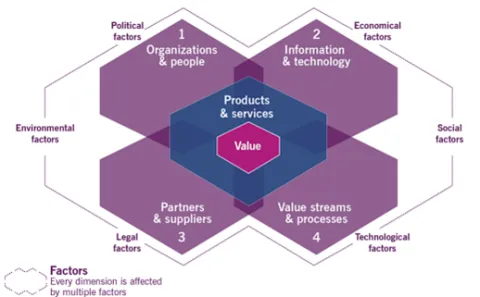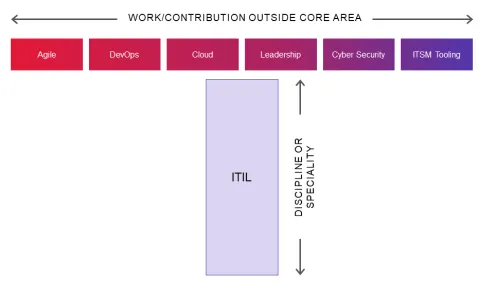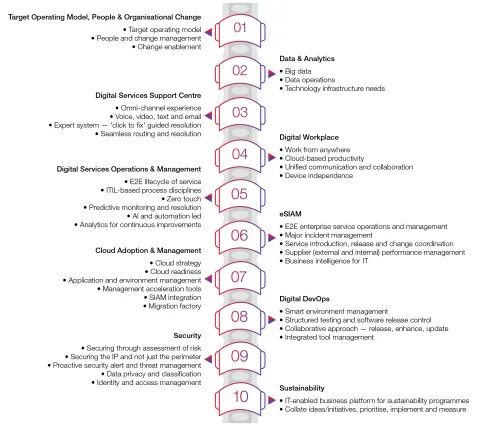Digital transformation can be described as a wildfire-like spread of connected technologies into all areas of an organisation. More than the simple adoption of new IT kits and cloud, it should fundamentally alter your operating model, transform the way you work and often radically change how you deliver value to customers. With this comes cultural changes too, requiring organisations to continually challenge the status quo, experiment and increase collaboration.
You may have read the title of this blog and thought “oh no, here we go again, another person claiming that the 30-year-old ITIL® model is the answer to everything!”, but that is not the case. I would like to instead present service management as a fundamental framework to underpin any successful digital transformation initiative.
A holistic view enables digital success
If I have learnt one thing in my 30+ years working with information systems, it is that any change involving the harmonisation of people, processes and technologies is likely to be a challenge. Digital transformation is no different, and modern service management emphasises that these three elements must be planned and implemented together.
The 4Ps (people, process, product, partners) of service design in ITIL®’s third iteration have evolved to become the four dimensions of service management in its current best practice.
The message remains the same: holistic thinking, planning, implementing together and considering any constraints on your solutions are essential to enabling the success of a digital organisation. Our experience at CGI emphasises that we can only provide our clients with impactful “insights you can act on” when we consider all possible factors that may inhibit a client’s desired outcomes.
Figure 1: Copyright © AXELOS Limited 2019. Reproduced under licence from AXELOS Limited. All rights reserved. Fig 3.1 ITIL® 4 Foundation.
Back to the basics
When choosing the basis for your digital transformation and operating model, you must consider two fundamental factors for your customer base:
- If a service is broken, customers want it fixed as quickly as possible.
- If you are changing a service, communicate with customers and get it right first time.
These pillars of service provision are now infinitely more important in our world of blockchain, smartphone-enabled, location independent apps than when we were previously sat in an office punching numbers into a Lotus Notes spreadsheet!
Business giant JD Rockefeller reportedly said that “the secret to success is to do the common things uncommonly well”. The 30 years’ experience built into ITIL®’s incident, problem and change practices therefore really should be considered by any organisation that wants to do these common things well!
Furthermore, change can be difficult and cause unease. Digital transformation changes longstanding ways of working and can lead to worries about roles, job security, sphere of influence, etc., so people often need a comfort blanket. This is something that an old friend like ITIL® can provide. Familiarity is key to successful change and the fundamentals still stand in a digital environment; changes need testing and incidents should still be prioritised against business needs.
Service management is one tool in the box
It is commonly believed that digitalisation, automation and agility are the death knell for process. Ironically this could not be further from the truth, as highlighted by the need for consistency pre-automation. Digital transformation requires integration between many process-rich areas such as operations management, projects, business analysis and enterprise architecture, and service management in the guise of ITIL® 4 acknowledges this by including many of these process areas in its 34 practices.
ITIL® 4 does not claim to know enterprise architecture better than The Open Group Architecture Framework (TOGAF), nor project management better than Project Management Institute (PMI), but it provides reliable advice on how disciplines should be integrated in the delivery of service. Service management is therefore one tool in the box, essentially tying everything together.
It is also worth recognising the change in profile of people performing these disciplines/jobs. The value of a single topic expert is essential, nevertheless, the profile of a skilled service management specialist is changing rapidly to effectively unify these various process areas and disciplines.
I am not alone in believing the modern service manager is now T-shaped! The downstroke of the T represents the core of a person’s service management expertise. The horizontal bar then highlights the whole host of skills that aid context and integration (in much less depth), including the likes of DevOps, cloud, project management, business change, sustainability, etc. No matter what these individual skills are, the ability to collaborate in an informed, effective manner with specialist colleagues in these areas is key.
The Digital Backbone
Reflecting this trend, our Advisory Services practice uses the Digital Backbone to draw together the many facets required to undertake successful digital transformation. Important to note is that enterprise service management (using the principles developed more than 30 years ago) remains alive and kicking in the organisations we partner with.
Our Digital Backbone holds together these various elements discussed; the links between them can be simple or complex, but the backbone enables a seamless transformation journey. It is also worth noting that our Digital Backbone features many of the elements present in the T-shaped service manager’s profile.
Whilst service management and ITIL® are not the only best practices exhibited here, I believe it is a vital presence that ties everything together. So, if you have consigned service management and ITIL® to the dustbin of history, maybe you should be taking another look!
If you'd like to find out more about our Digital Backbone approach and how we use best practices to help transform our clients’ organisations, visit our webpage.








